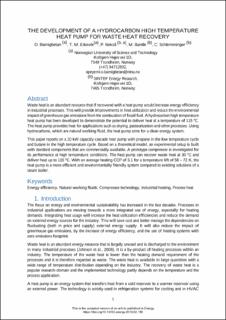| dc.contributor.author | Bamigbetan, Opeyemi Olayinka | |
| dc.contributor.author | Eikevik, Trygve Magne | |
| dc.contributor.author | Nekså, Petter | |
| dc.contributor.author | Bantle, Michael | |
| dc.contributor.author | Schlemminger, Christian | |
| dc.date.accessioned | 2020-03-30T14:05:17Z | |
| dc.date.available | 2020-03-30T14:05:17Z | |
| dc.date.created | 2019-01-31T14:26:32Z | |
| dc.date.issued | 2019 | |
| dc.identifier.citation | Energy. 2019, 173 1141-1153. | en_US |
| dc.identifier.issn | 0360-5442 | |
| dc.identifier.uri | https://hdl.handle.net/11250/2649491 | |
| dc.description.abstract | Waste heat is an abundant resource that if recovered with a heat pump would increase energy efficiency in industrial processes. This will provide improvements in heat utilization and reduce the environmental impact of greenhouse gas emissions from the combustion of fossil fuel. A hydrocarbon high temperature heat pump has been developed to demonstrate the potential to deliver heat at a temperature of 115 °C. The heat pump provides heat for applications such as drying, pasteurization and other processes. Using hydrocarbons, the heat pump aims for a clean energy system. This paper reports on a 20 kW capacity cascade heat pump with propane in the low temperature cycle and butane in the high temperature cycle. Based on a theoretical model, an experimental setup is built with standard components that are commercially available. A prototype compressor is investigated for its performance at high temperature conditions. The heat pump can recover waste heat at 30 °C and deliver heat up to 115 °C. With an average heating coefficient of performance (COP) of 3.1 for a temperature lift of 58–72 K, the heat pump is a more cost efficient and environmentally friendly system compared to existing solutions of a steam boiler. | en_US |
| dc.language.iso | eng | en_US |
| dc.publisher | Elsevier | en_US |
| dc.rights | Attribution-NonCommercial-NoDerivatives 4.0 Internasjonal | * |
| dc.rights.uri | http://creativecommons.org/licenses/by-nc-nd/4.0/deed.no | * |
| dc.title | The development of a hydrocarbon high temperature heat pump for waste heat recovery | en_US |
| dc.type | Peer reviewed | en_US |
| dc.type | Journal article | en_US |
| dc.description.version | acceptedVersion | en_US |
| dc.source.pagenumber | 1141-1153 | en_US |
| dc.source.volume | 173 | en_US |
| dc.source.journal | Energy | en_US |
| dc.identifier.doi | 10.1016/j.energy.2019.02.159 | |
| dc.identifier.cristin | 1670645 | |
| dc.relation.project | Norges forskningsråd: 257632 | en_US |
| dc.relation.project | Norges forskningsråd: 243679 | en_US |
| cristin.unitcode | 7548,60,0,0 | |
| cristin.unitcode | 7548,70,0,0 | |
| cristin.unitname | Gassteknologi | |
| cristin.unitname | Termisk energi | |
| cristin.ispublished | true | |
| cristin.fulltext | postprint | |
| cristin.qualitycode | 2 | |

